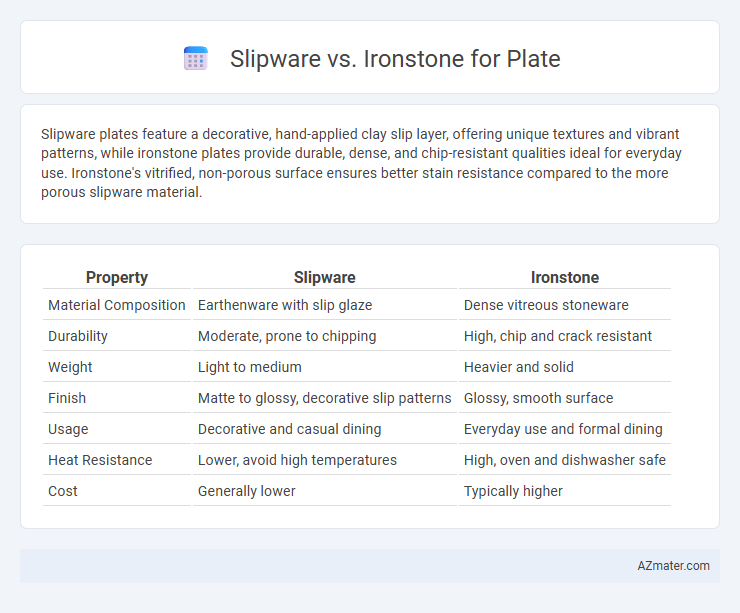Slipware plates feature a decorative, hand-applied clay slip layer, offering unique textures and vibrant patterns, while ironstone plates provide durable, dense, and chip-resistant qualities ideal for everyday use. Ironstone's vitrified, non-porous surface ensures better stain resistance compared to the more porous slipware material.
Table of Comparison
| Property | Slipware | Ironstone |
|---|---|---|
| Material Composition | Earthenware with slip glaze | Dense vitreous stoneware |
| Durability | Moderate, prone to chipping | High, chip and crack resistant |
| Weight | Light to medium | Heavier and solid |
| Finish | Matte to glossy, decorative slip patterns | Glossy, smooth surface |
| Usage | Decorative and casual dining | Everyday use and formal dining |
| Heat Resistance | Lower, avoid high temperatures | High, oven and dishwasher safe |
| Cost | Generally lower | Typically higher |
Introduction to Slipware and Ironstone Plates
Slipware plates feature a decorative technique using liquid clay slip applied to the surface before firing, creating unique patterns and textures ideal for artisanal tableware. Ironstone plates, developed in the 19th century, emphasize durability and a smooth, dense body resembling porcelain but with enhanced resistance to chipping and staining. Both types highlight distinct aesthetic and functional qualities, with slipware offering rustic charm and ironstone presenting practical elegance for everyday use.
Historical Origins of Slipware and Ironstone
Slipware originated in the Middle Ages, characterized by the application of liquid clay slip to create decorative patterns on pottery, predominantly in England and Europe during the 16th to 18th centuries. Ironstone, developed in early 19th-century England by potter Charles James Mason, is a durable, vitreous stoneware designed as an affordable alternative to porcelain with a dense, non-porous body. Both slipware and ironstone represent significant advancements in pottery techniques, reflecting the evolving demands for functional and decorative ceramics throughout history.
Material Composition: Slipware vs Ironstone
Slipware plates are made from earthenware clay coated with a slip, a liquid mixture of clay and water, which gives a decorative and slightly porous surface that is less durable and more prone to chipping. Ironstone plates consist of vitrified stoneware clay with a high iron content, making them denser, heavier, and much more durable, resistant to chipping and cracking compared to slipware. The material composition difference results in ironstone plates offering superior strength and longevity, while slipware provides traditional aesthetics with a more delicate finish.
Distinctive Aesthetic Features
Slipware plates exhibit a distinctive aesthetic characterized by their vibrant, hand-painted slip designs often featuring swirls, dots, and floral motifs, resulting in a rustic, artisanal charm. Ironstone plates are noted for their smooth, glossy finish with simple yet elegant patterns, including embossed details and glazed white or cream surfaces that evoke a classic, durable look. The contrast between slipware's colorful, textured appearance and ironstone's sleek, refined style underscores their unique visual appeal for collectors and everyday use.
Durability and Strength Comparison
Slipware plates, crafted with a decorative slip coating, offer moderate durability but are more prone to chipping and scratching compared to Ironstone. Ironstone plates, made from dense, vitrified stoneware, provide superior strength and resistance to impact, making them highly durable for daily use. The non-porous glaze on Ironstone enhances its hardness and longevity, surpassing Slipware in terms of overall durability.
Everyday Use and Functionality
Slipware plates, characterized by their decorative glaze and porous surface, require careful handling and are best suited for light everyday use due to their potential for chipping and staining. Ironstone plates offer superior durability and resistance to chipping, making them ideal for heavy daily use in busy kitchens or households. The non-porous, dense composition of ironstone enhances its functionality by providing ease of cleaning and long-lasting resilience compared to the more delicate slipware.
Collector Value and Rarity
Slipware plates, known for their hand-decorated slip designs, often hold higher collector value due to their artisanal uniqueness and limited production, making each piece rare and desirable. Ironstone plates, characterized by their durable vitreous pottery and mass-produced nature during the 19th century, are generally less rare but appreciated for their robust quality and historical significance. Collectors value slipware primarily for its decorative individuality and scarcity, whereas ironstone is prized more for its durability and connection to industrial pottery heritage.
Maintenance and Care Requirements
Slipware plates require gentle hand washing with mild detergent to preserve their intricate glaze and avoid chipping, as they are more porous and prone to staining. Ironstone plates offer superior durability and resistance to scratches, making them dishwasher-safe and easier to maintain over time without losing their glossy finish. Proper care for slipware involves avoiding abrasive scrubbers and extreme temperature changes, while ironstone withstands everyday use with minimal special attention.
Price Points and Accessibility
Slipware plates typically offer more affordable price points due to the simpler materials and traditional handcrafted techniques used, making them accessible to a wider range of buyers and collectors. Ironstone plates, known for their durability and classic appeal, tend to be priced higher, reflecting their heavier weight and often more intricate manufacturing processes. Both options provide functional and decorative choices, but slipware's accessibility and affordability make it a popular choice for everyday use.
Choosing Between Slipware and Ironstone Plates
Choosing between slipware and ironstone plates involves evaluating durability and aesthetic preferences; ironstone offers superior strength and chip resistance ideal for everyday use, while slipware provides unique handcrafted designs with a rustic, artisanal appeal. Slipware's porous surface requires careful maintenance to prevent staining, whereas ironstone's non-porous glaze ensures easier cleaning and long-lasting hygiene. Consider slipware for decorative or occasional use and ironstone for practical, heavy-duty dining settings.

Infographic: Slipware vs Ironstone for Plate
 azmater.com
azmater.com